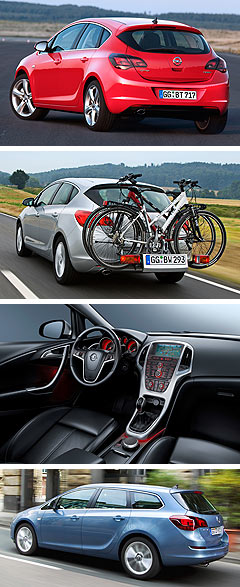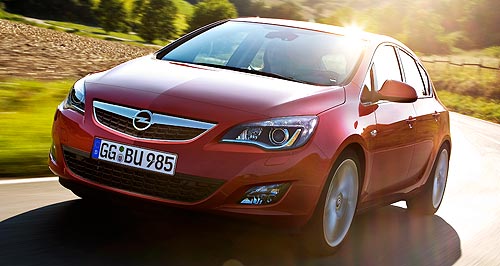Future models - Opel - AstraFirst drive: Astra to spearhead Opel onslaughtFamily ties: The Opel Astra range will open with the same 1.4-litre turbo-petrol engine that powers the Holden Cruze CD ‘iTi’ when it arrives in Australia next year. Slick new Opel Astra to lead German GM brand’s Australian introduction next year30 Sep 2011 GENERAL Motors’ long-lamented Astra nameplate will return to Australia around this time next year, but this time it will be accompanied by Opel – rather than Holden – badges on an all-new model to become available via the first local dealer network for the mainstream German brand. GM has high hopes for the born-again Astra in Australia – where the previous AH generation was discontinued in 2008, just months before the current model was released in Europe – with no less than half of an eventual 15,000 annual Opel sales expected to come from the small hatchback and wagon model line. That is a far cry from the Astra’s best local sales year of 2005 (when 34,218 were sold) and less than one-fifth of the sales volume achieved by the top-selling Mazda3 and Toyota Corolla in Australia’s largest single vehicle segment last year. It would also make the Astra about half as popular as its most direct rival, the Volkswagen Golf, which last year sold 15,425 units in Australia while commanding a near-30 per cent segment share at home in Germany, ahead of the Astra with almost 10 per cent. However, it would also make the Astra one of Australia’s top 10 small cars, giving GM a second model in the booming segment alongside Holden’s mechanically similar Cruze sedan, which so far this year has outsold the Corolla and will next month be joined by the Australian-designed Cruze hatch.  Although it will be priced higher than the Cruze (which currently opens at $21,240 plus on-road costs) at around the same price as the Golf (from $21,990), the five-door Astra hatch will come with a 1.6-litre turbocharged petrol engine that is more advanced than the Cruze’s range-opening naturally aspirated 1.8-litre petrol four. Although it will be priced higher than the Cruze (which currently opens at $21,240 plus on-road costs) at around the same price as the Golf (from $21,990), the five-door Astra hatch will come with a 1.6-litre turbocharged petrol engine that is more advanced than the Cruze’s range-opening naturally aspirated 1.8-litre petrol four.The Astra hatch and ‘Sports Tourer’ wagon range will, however, open with the same 1.4-litre turbo-petrol engine that powers the Cruze CD ‘iTi’ (from $22,490) and SRi sports models, as well as the 2.0-litre turbo-diesel seen in the Cruze CDTi (from $24,990). GoAuto drove all three engines across both new Astra body styles in Germany following this month’s Frankfurt motor show, where Opel staged the world production debut of the all-new Astra GTC Coupe that could join the mainstream hatch and wagon models on sale from launch next October. It is not yet known whether the Astra, model for model, will match the level of standard equipment seen in small-car leaders like the newly facelifted Mazda3, which this week also received a $1000 base price cut, to $20,330. However, after a solid two-day drive in the Rheingau region around Opel’s Russelsheim headquarters, it is clear that – despite sharing the same GM Delta II small-car platform as the Cruze – the German-tuned Astra delivers a higher level of handing dynamics than its Korean-based, Australian-designed and manufactured sibling. Unlike its two most direct German-engineered rivals, the Golf and Ford Focus, the Astra eschews a more expensive independent rear suspension layout for a simpler Watts link solid rear axle set-up, but adds the larger Insignia’s FlexRide variable damping system to deliver a comparably classy ride/handling set-up, at least on German roads. Opel’s latest Astra combines high levels of refinement and noise suppression with a rock-solid body and well-sorted chassis, making it one of the most rewarding small cars on the road. The Astra’s electrically assisted power steering offers German precision and is well isolated from kick, rattle and torque-steer, but is not quite as polished as the Golf’s more consistently weighted steering or the Focus’s more communicative tiller, both of which are also electric. However, once again the Astra tends to make up for this with its unique (albeit optional) FlexRide system, which not only allows drivers to effectively adjust damping performance across three modes – Standard, Tour and Sport – but also steering assistance, throttle pedal travel and (automatic) transmission shift performance. All three engines will be available with both six-speed manual and automatic transmissions, with GM’s new 1.4 turbo-petrol four delivering spirited, refined performance in Australia’s entry-level Astra – as it does in the Cruze, which delivers the same 103kW and 200Nm outputs, while the Astra 1.4 manual hatch returns fuel consumption of 5.9L/00km. Naturally, the 132kW/230Nm 1.6 turbo-petrol engine provides a bigger dose of performance without any detriment to refinement, but the 118kW/350Nm 2.0-litre turbo-diesel is the pick of the bunch, delivering outstanding city and highway torque delivery along with 4.9L/100km efficiency, even if there is a whiff of turbo lag and plenty of diesel clatter – especially when cold. However, the Astra moves one step ahead of the Golf with a well-designed cabin layout that is both functional and highly ergonomic, as well as being pleasing on the eye. The dashboard does not present the same high-quality materials as the Insignia mid-sizer, but the instruments and centre stack feature basically the same aesthetic design and all touch surfaces are just as soft. And the design and build quality of all Astras we drove was impeccable. Apart from coming standard with the full gamut of safety features – including four-channel ABS brakes with electronic brake-force distribution and traction/stability control – the Astra is available in Europe with high-end equipment such as adaptive bi-Xenon headlights, speed sign recognition, six-way power front seat adjustment and Opel’s novel FlexFix integrated bicycle carrier. The newest Astra hatch and wagon will both be recognisable to Australians, who had access to the Holden-badged Opel small cars between 1996 and 2008. At 4419mm long, the hatch is more than 200mm longer than the five-door Golf, while the wagon has the same 2685mm wheelbase but measures 4698mm long – making it about 70mm longer than the Golf wagon. The Astra wagon not only increases total cargo capacity to 1550 litres (55 litres more than the Golf wagon), but features Opel’s unique-in-class FlexFold seating system, which stows the rear seats at the push of a button. The Astra line-up will be topped by the super-stylish GTC three-door, which like the Astra will be available in Europe with three turbocharged petrol engines – 88kW and 103kW 1.4-litre and 132kW 1.6-litre – and three turbo-diesels: 81kW and 96kW 1.7-litre and 121kW 2.0-litre, each with standard idle-stop systems. Expect the Astra GTC Coupe range to be crowned in 2013 by the red-hot OPC version, which will look a lot like last year’s sexy GTC Paris concept car and could upstage both the front-drive Golf GTI, front-drive Scirocco R and all-wheel drive Golf R (188kW) by packing as much as 224kW (300hp) from a twin-scroll turbo-petrol four with idle-stop. Given that will give Opel broad coverage of Australia’s booming small-car segment, there’s no reason GM’s latest Astra can’t re-establish a solid following for itself Down Under, Holden badge or not.  Read more27th of September 2011  First drive: Opel’s wild new Corsa OPC NurburgringTop-shelf OPC Nurburgring Edition shows there’s plenty of life yet in Opel’s Corsa20th of September 2011  Crazy Opel commuter not just for showOpel confirms it is developing a business case for radical RAK-e four-wheeled bike19th of September 2011  Opel firms 2012 Oz launch line-upGTC Coupe could top Corsa, Astra and Insignia in Opel Australia’s launch line-up15th of September 2011  Opel eyes 15,000 salesOz to be a key plank in Opel’s global expansion with 15,000 sales forecast by 2015All future models Alfa Romeo Alfa Romeo Abarth Abarth Audi Audi Aston Martin Aston Martin BMW BMW Bentley Bentley Chrysler Chrysler Chevrolet Chevrolet Dodge Dodge Citroen Citroen Ferrari Ferrari DS DS Ford Ford Fiat Fiat FPV FPV Foton Foton Haval Haval Great Wall Great Wall Honda Honda Holden Holden Hyundai Hyundai HSV HSV Isuzu Isuzu Infiniti Infiniti Jeep Jeep Jaguar Jaguar Lamborghini Lamborghini Kia Kia Lexus Lexus Land Rover Land Rover Mazda Mazda Maserati Maserati Mercedes-Benz Mercedes-Benz McLaren McLaren Mini Mini Nissan Nissan Mitsubishi Mitsubishi Peugeot Peugeot Opel Opel Proton Proton Porsche Porsche Renault Renault Ram Ram Saab Saab Rolls-Royce Rolls-Royce Smart Smart Skoda Skoda Subaru Subaru SsangYong SsangYong Tesla Tesla Suzuki Suzuki Toyota Toyota Volvo VolvoMotor industry news |
Click to shareOpel modelsResearch Opel All future models Alfa Romeo Alfa Romeo Abarth Abarth Audi Audi Aston Martin Aston Martin BMW BMW Bentley Bentley Chrysler Chrysler Chevrolet Chevrolet Dodge Dodge Citroen Citroen Ferrari Ferrari DS DS Ford Ford Fiat Fiat FPV FPV Foton Foton Haval Haval Great Wall Great Wall Honda Honda Holden Holden Hyundai Hyundai HSV HSV Isuzu Isuzu Infiniti Infiniti Jeep Jeep Jaguar Jaguar Lamborghini Lamborghini Kia Kia Lexus Lexus Land Rover Land Rover Mazda Mazda Maserati Maserati Mercedes-Benz Mercedes-Benz McLaren McLaren Mini Mini Nissan Nissan Mitsubishi Mitsubishi Peugeot Peugeot Opel Opel Proton Proton Porsche Porsche Renault Renault Ram Ram Saab Saab Rolls-Royce Rolls-Royce Smart Smart Skoda Skoda Subaru Subaru SsangYong SsangYong Tesla Tesla Suzuki Suzuki Toyota Toyota Volvo VolvoMotor industry news |
















Facebook Twitter Instagram